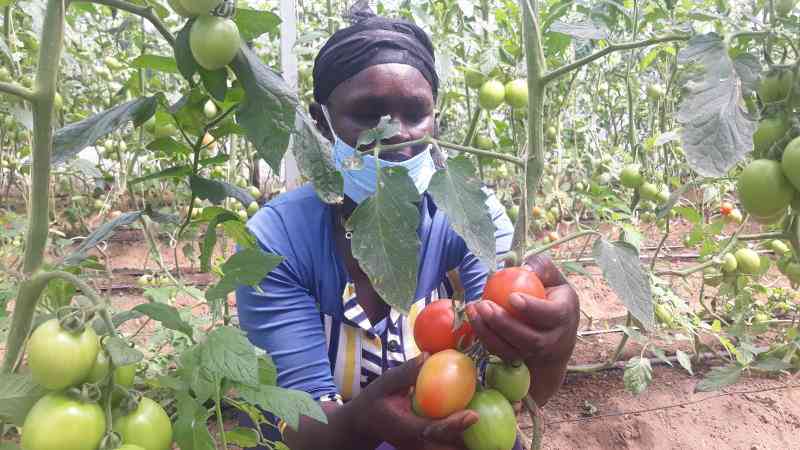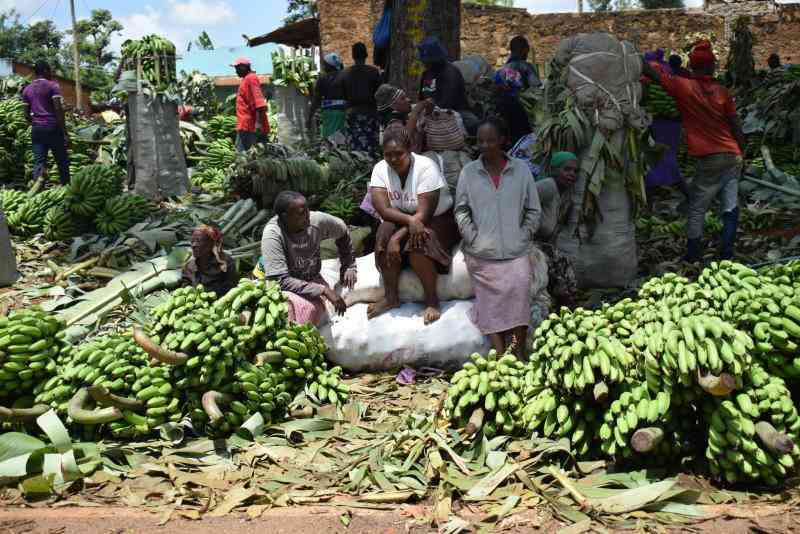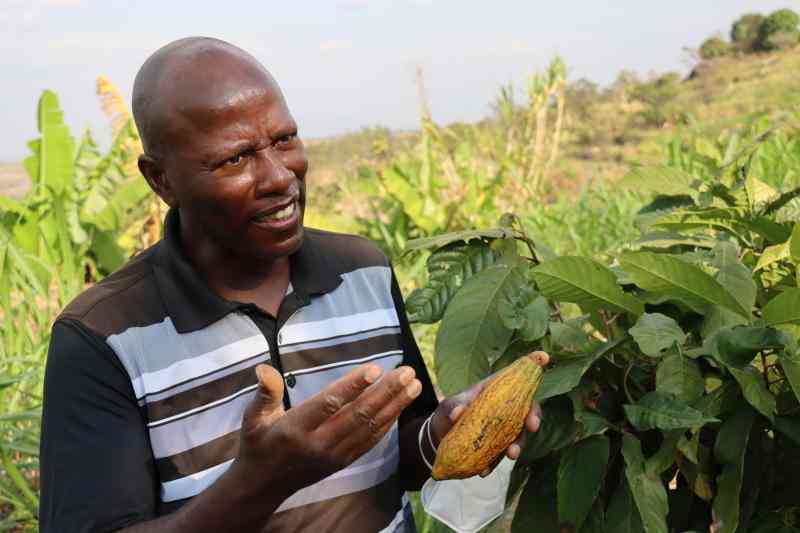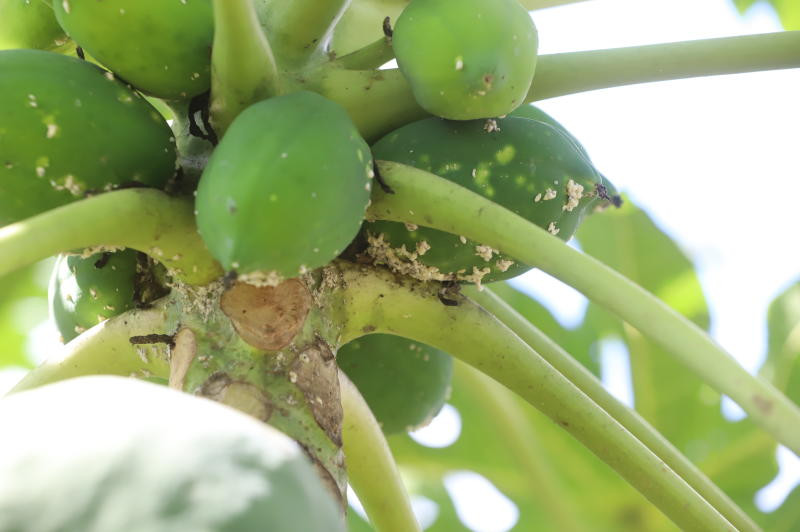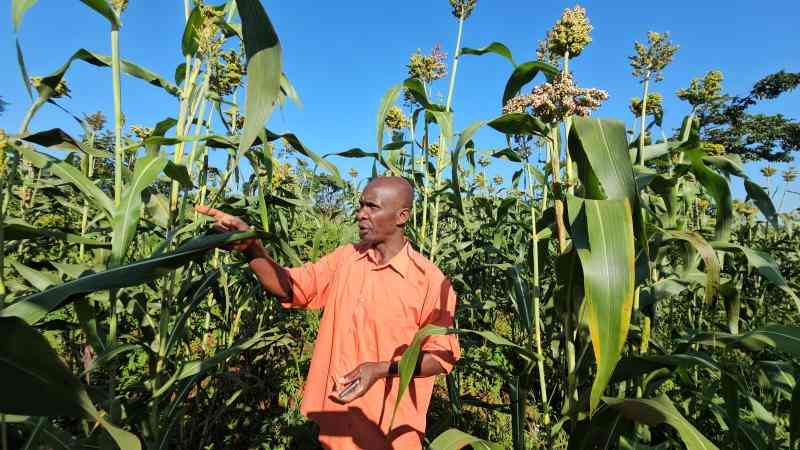
Douglas Ouma is a farmer in Matayos constituency, Busia county. In 2023 he has not grown maize as the crop has never earned him a substantial profit. He has planted groundnuts, sorghum, and millet - drought tolerant crops that also fetch him good money at the market [Gardy Chaha, Standard]
In much of Kenya's breadbasket, maize is a flagship crop, which is not unusual as the grain is the most consumed cereal in the country.
"It is almost part of our culture to farm maize. Every family grows maize," says Douglas Ouma, a farmer in Matayos Constituency, Busia county.
So loved is the cereal that when the average Kenyan talks about food security, they probably mean the availability - or lack thereof - of maize.
And, in some communities in western Kenya, someone is said to have gone hungry if their last meal did not comprise ugali - a type of corn meal made from maize or corn flour.
Maize is Kenya's staple food. It is primarily consumed in the form of ugali. It can also be consumed as boiled or mixed with beans (githeri).
Official data shows that Kenyans consume an average of 45 million bags of maize every year. This is against the production of 34.3 million bags in 2022.
In other words, despite the commitment to grow maize, Kenya still needs to import to meet demand.
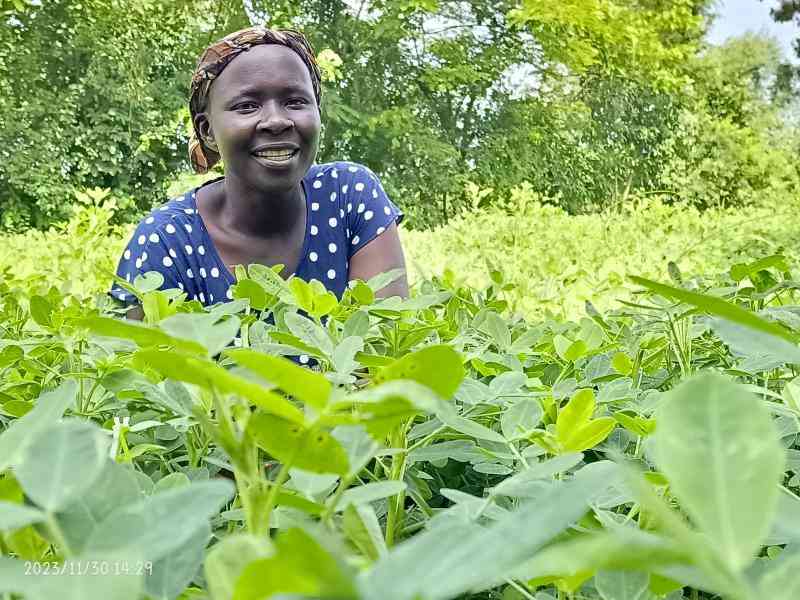
Wilkister Auma is making money farming groundnuts in Poye village, Siaya county. She used to grow maize routinely. Now, she only grows enough for domestic use, and is using najority of farm land available to her for commercial groundnuts farming. [Gardy Chaha, Standard]
Be that as it may, one would expect that with such high demand, maize farming would be incredibly profitable. The opposite is, however, true.
"Farmers get very little - or sometimes make a loss - farming maize," says Evans Nyesi, an expert in development economics.
Farmers have perennially begged the government to halt the importation of the cereal to allow them to sell their produce profitably.
Nyesi, a farmer himself, admits maize farming can sometimes be a loss-making venture.
"I farmed maize on three-quarters of an acre not long ago. I got four [90kg] bags of maize. The market price was Sh4,000 per bag. I made Sh16,000.
"In my calculations, the cost of land preparation, fertiliser, weeding, pesticides, and other processes leading up to the point of sale don't square with the returns," he says.
"On the same piece of land, I planted sorghum. I got two bags - without using any fertiliser or pesticide - and sold the sorghum at Sh200 per 2kg tin. I made 18,000. I felt sorghum's profitability. I am not sure I made anything from the maize," says Nyesi.
Maize production has declined consistently in recent years. For instance, it declined from 42.1 million bags in 2020 to 36.7 million bags in 2021 and then to 34.3 million bags in 2022.
Experts have blamed a myriad of factors, including climate change; pest infestation, such as the 2017 scourge of fall armyworms and a lack of enough fertiliser.
While this is not in question, not much consideration has been given to the decreasing appetite among farmers to cultivate the crop.
Yet, farmers like Ouma (who has been at it since 2012), have almost entirely stopped growing maize.
"This year I haven't grown maize: I am growing sorghum, groundnuts, and finger millet," he says.
Value chains
This writer experienced firsthand the turnaround in his fortunes during a recent tour of his farm.
Ouma, 34, is among at least 150,000 youthful farmers, who are part of a project known as Drought Tolerant Crops (DTC) for Youth Jobs Creation, implemented by Africa Harvest Biotech Foundation International, International Crop Research Institute for Semi-Arid Tropics (ICRISAT) in partnership with the Mastercard Foundation.
"The project has picked eight key agricultural value chains - sorghum, finger millet, pearl millet, groundnuts, pigeon peas, green grams, poultry and fish.
"The selected value chains are resilient to climate challenges, reducing weather-related risks that often discourage young farmers," says Nehemiah Mburu, the Technical Lead in charge of the project.
Twenty-eight-year-old Elisha Ayoo from Kipasi in Homabay County focuses on commercial sorghum farming.
He says: "Sorghum is early maturing. In three months, I harvest and sell the produce to an aggregator who then delivers it to Capwell Industries in Nairobi."
"Maize is loved everywhere, but I wouldn't plant maize if the intention is to make a profit. For me, this is my source of living. The same way those employed in the corporate world depend on a salary is the same way I depend on farming. Therefore, I cannot afford to follow the trend of growing maize thoughtlessly."
The influence of maize on Kenya's social life is compelling. Maize production and consumption is fodder for politicians.
President William Ruto last year promised to lower the cost of maize flour.
In November this year, in response to public outcry about the cost of living, Agriculture and Livestock Cabinet Secretary Mithika Linturi promised that a 2kg packet of maize flour would start retailing at Sh120 within weeks - a promise that never materialised.
Opposition leader Raila Odinga rode on the issue, mobilising his supporters to street protests to compel the government to address the high cost of living crisis.
"The regime must take immediate steps to bring back the cost of unga to Sh100," Raila scoffed in April.
"The opposition is demonstrating with Sufuria's on their heads, can that bring down the price of unga?" rebuffed President Ruto.
The government always gets caught between responding to the cries of the masses, who want cheaper flour and appeasing maize growers, who want to rip profits selling their maize.
In 2020, the government responded with subsidised fertiliser for maize farmers and the greenlighting of GM (genetically modified) maize.
Scientists warn Kenyan farmers cannot continue to rely on maize if they want to make a profit and also if they want to make the country food secure.
Dr Henry Ojulong, a plant breeder with ICRISAT - a non-political public international research organisation - says maize is classified as a C3 metabolic plant, meaning it needs water for the most of its life.
"Climate change is here. Many areas are now receiving little or no rain for long periods. Plants grouped as C4 are drought-tolerant. They include sorghum, millet and most legumes," he says.
C4 plants, he explains, achieve drought tolerance through several mechanisms.
First, some have a deep tap root system that draws water beyond the reach of maize. Hence, they have higher chances of survival during drought.
They also are early maturing like groundnuts, which are ready for harvest in three months. With just a little rain, the crop can germinate and flower. Before drought becomes severe it would be ready for harvesting.
"Some of the plants have developed morphologically. For instance, when there is water stress, sorghum will roll its leaves to reduce transpiration," says Dr Ojulong.
In Poye village, Siaya county, we find Wilkister Auma's nine-year-old son riding a relatively new bicycle.
"This is a 'Buffalo'," Auma says, pointing at the bike. "I bought it after selling 178kg of unshelled groundnuts last season."
Auma sold the produce at Sh23,790, hard to come by in rural Siaya.
"Not until now did I know that farming can earn some good money for a small-scale farmer like me."
In total, she harvested just over 250kg of unshelled nuts. She also kept some for domestic use.
Auma has also begun converting some of her groundnuts into peanut butter.
"I shell the nuts myself, dry them, roast them, then take them to Agricultural Technology Development Center (ATDC) in Siaya Town, where they have a machine that grinds roasted nuts into peanut butter."
Demand for the peanut butter is high, she says.
"With groundnuts, I put little effort, and the cost of production is low. With maize, I need fertiliser to top dress (twice), I need to do weeding (twice), I need to buy seeds (at Sh1,200 per 2kg packet), and so on."
Speaking to this writer earlier in the year, climate change scientist, Dr Linda Ogallo commented that farmers, now more than ever, ought to be smart at what they do.
"They should link up with local meteorological officers as well as extension officers to receive critical information (on what and when to plant)."
Ogallo, a scientist at IGAD Climate Prediction and Applications Centre, says farmers have no option but to adopt climate-smart practices.
 The Standard Group Plc is a multi-media organization with investments in media platforms spanning newspaper print
operations, television, radio broadcasting, digital and online services. The Standard Group is recognized as a
leading multi-media house in Kenya with a key influence in matters of national and international interest.
The Standard Group Plc is a multi-media organization with investments in media platforms spanning newspaper print
operations, television, radio broadcasting, digital and online services. The Standard Group is recognized as a
leading multi-media house in Kenya with a key influence in matters of national and international interest.

